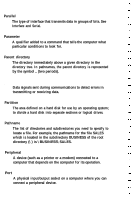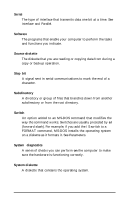Epson Apex 200 User Manual - Page 239
Power-on diagnostics, Primary partition, Program, Prompt, Read/write head, Real-time clock
 |
View all Epson Apex 200 manuals
Add to My Manuals
Save this manual to your list of manuals |
Page 239 highlights
Power-on diagnostics The system tests the computer runs to check its internal circuitry and configuration each time you turn it on. Primary partition The MS-DOS partition from which the operating system starts. Program A disk file that contains coded instructions and tells a computer what to do and how to do it. Prompt A message displayed on the screen that tells you what action you need to perform next. RAM Random Access Memory. The portion of the computer's memory used to run programs and store data while you work. All data stored in RAM is erased when you turn off the computer; so you must store any data you want to keep on a diskette or hard disk. Read To move data from one area to another. For example, when you open a text file stored on disk, the computer reads the data from the disk and displays it on the screen. Read/write head The physical device inside a disk drive that reads and records data on the magnetic surface of a disk. Real-time clock A battery-powered clock inside the computer that keeps track of the time and date, even when the computer is turned off. Glossary 13















